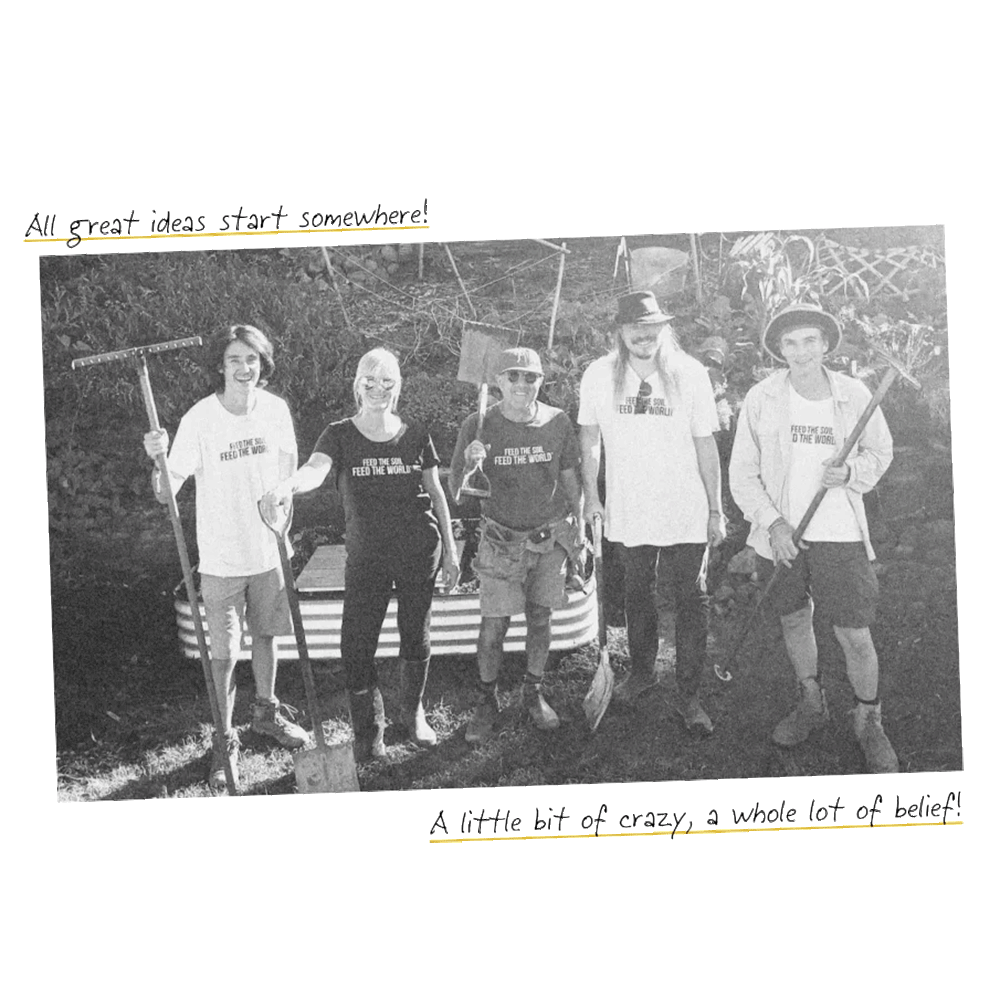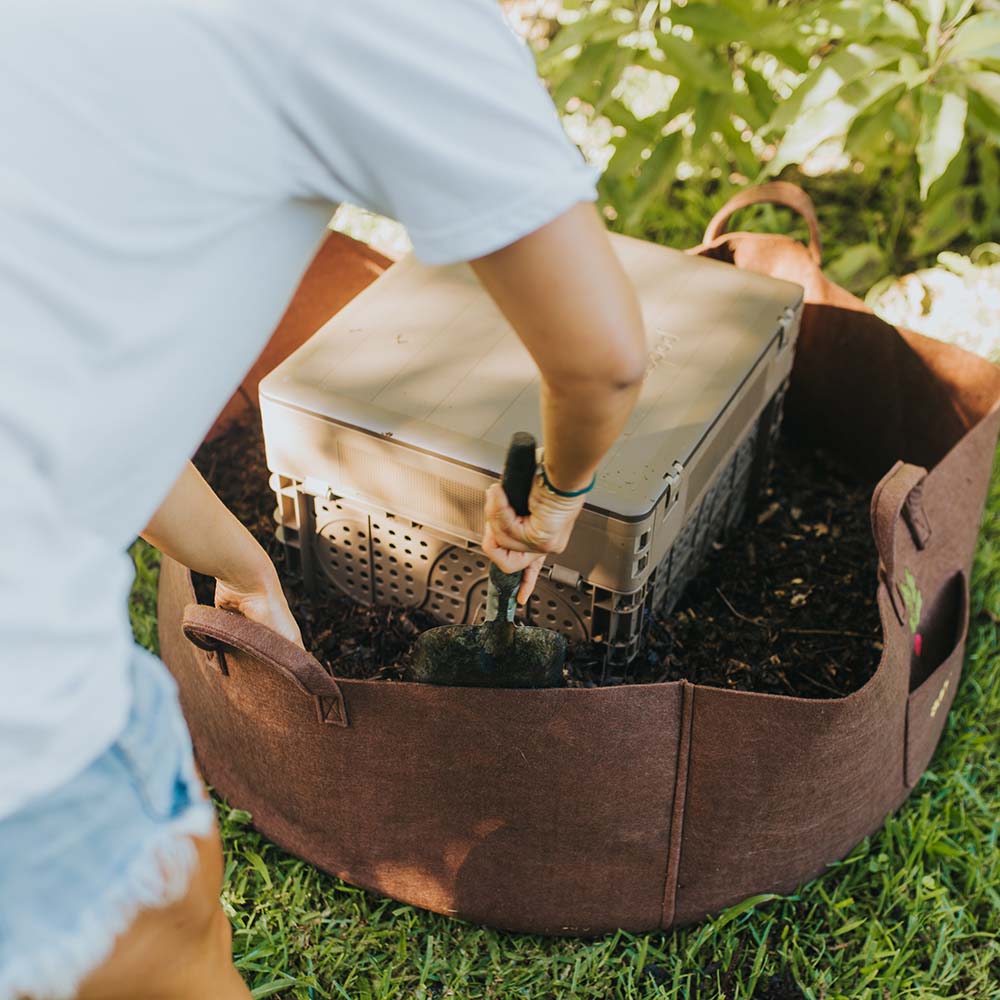The Subpod is designed to be vermin and pest free, but to quote everyone’s favorite Jurassic Park character, Dr. Ian Malcolm - “Life, uh, finds a way.” :/
Before we tell you how to give these guests a hint that it might be time for them to move along, we’d like to talk to you a little about the ecosystems found in soil and compost.
Compost systems need to be vermin-proof to prevent attracting unwanted wildlife such as rats, possums, or larger animals. But what we consider a “pest” isn’t always what it seems.
These are the most common guests you’re likely to find in your Subpod:
- Cockroaches
- Ants
- Black Soldier Fly Larvae (maggots)
In nature, worms, cockroaches, flies, and ants, along with many more insects, all play a role in composting organic matter. They generally work in harmony – it's only when one species threatens another that issues will arise!
For example, black soldier fly larvae are commonly found in compost. While it might be undesirable to see these guests in your Subpod, having a few of them in your compost won’t hurt your worms. But if allowed to breed for months, without population control, they could eventually force your worms out into the soil for good. At the end of the day, your Subpod is an ecosystem, so it’s all about balance.
Now that you know a little more about the ecosystem inside you Subpod, here’s how to get any visitors making themselves a little too at home to move along.
Common insects you'll find in your Subpod, and how to help them move along:
Ants
General Ants
Ants tend to colonize a Subpod if the system is too dry. This can happen if your worm blankets aren't regularly soaked, or if the food waste is not stirred in. If your scraps are left to sit on top of the bedding of the Subpod, even under the worm blankets, they can dry out and cause issues.
Chopping up your waste prior to putting it in your kitchen collection bucket will make it easy to stir your scraps in when you go to add them to the Subpod. It's also always good to make sure your compost is moist, but not wet, as this will not be appealing to ants.
To encourage ants to move along, soak your worm blankets well, add a bit of damp newspaper you've soaked in water into your system and areate your compost. The ants should move along quickly!
Fire Ants
If you find fire ants on your property in the area around the Subpod, rather than pesticides, try borax mixed with sugar: https://ants.com/using-borax-powder-to-kill-ants/
Using Borax to Kill Fire Ants
Fire ants are an invasive species that can cause plenty of issues if they decide to create a nest in your yard. Luckily, borax also effectively kills these colonies. Just keep in mind that you want to try to kill just the fire ants and not any indigenous ants. This is because if you kill every ant in your yard, you’re only leaving room for more fire ants to move in and take over the area.
Sparing the indigenous ants will help keep the ecosystem balanced. The easiest way to focus your borax baits for just fire ant consumption is to get a container of bait as close to the fire ant mound as safely possible. Then let the worker ants take care of the rest.
If you find ants in your home or yard, you now know how you can use borax to make liquid and solid baits to attract ants and ultimately kill the colony.
Cockroaches
If you notice cockroaches in your Subpod, the fix is quite simple! First stop feeding your system, then add in large amounts of damp newspaper you've soaked in water. You should only have to wait a week or so until the cockroaches leave, and once they have, you can begin composting again as normal.
Snakes, lizards & geckos
Generally most snakes, lizards & geckos won't be able to get inside a Subpod as it's designed to be vermin-proof – but if your lid gets left open they might find their way in!
The best way to get them to move along is to simply remove them, unless it's a venemous snake in which case we recommend getting a specialist to safely rehome it.
If you have Red Wrigglers, you don't have to worry as much about the presence of snakes, blind snakes and lizards in your Subpod. Red wrigglers can emit a noxious fluid that prevents them from being appealing to animals such as fish, birds and snakes.
Flies
Be sure to check that the larger holes on the sides of your Subpod are below the soil line in your garden bed. https://growhub.subpod.com/posts/getting-started-with-subpod-is-your-soil-line-at-the-correct-height
Flies can also enter the Subpod when you are adding your food waste, or before your food scraps are added to the Subpod. This can happen when there is a loose lid and the sneaky little fruit flies sneak in when you are not looking.
Here are some tips for dealing with flies:
- Be sure to have a kitchen caddy/container with a tight sealing lid.
- Use a lock on the Subpod to keep the lid locked shut whilst you aren't using it :)
- The more thoroughly you stir your food waste into the bedding, the less likely you will have a problem with flies and other insects. If you add a bit more moist bedding (moist carbon), it is easier to bury the food waste thoroughly when you are first getting going.
- Chop your food scraps up to smaller pieces during food prep. This will ensure that they break down faster in the Subpod, making it easier to bury as you mix them in, and your worm population will grow faster.
- There are also some simple non-toxic solutions for fruit flies, like this fruit fly trap: https://youtu.be/AnDCReoxdHo
It is important to note that flies will not hurt the worms at all, and once your worm population grows, the quicker the scraps will compost to maintain a robust system that can easily handle the occasional fruit fly stowaways hitching a ride into the Subpod from your food scraps.
Black Soldier Fly Larvae
Black soldier fly larvae will eat kitchen scraps faster than compost worms, especially in hot weather. Although the black soldier fly larvae do not harm the worms, it’s best to make sure they do not overtake your system completely.
There are two ways to do this:
1) Pick out the Black Soldier Flies with your hands and add in dry carbon (sawdust is best)
2) If you would rather not touch any Black Soldier Flies, simply stop feeding the system and add in dry carbon (sawdust is best)
Other dry carbon includes: shredded newspaper, crushed dried leaves, or dried grass clippings.
A couple of suggestions to prevent Black soldier flies from entering your Subpod are:
-
Keep your waste covered as much as possible while you are collecting it, so the flies can’t lay eggs in it before it gets to your compost system. You can use sealed compost bins/containers in your kitchen to seal your food scraps and keep out any unwanted pests.
-
Make sure the soil line is up to the ventilation level, so all the holes are covered.
Masked Chafers
Interestingly enough, adult masked chafers don't actually feed on your compost – it's the larval stages that are attracted to moist soil with high organic matter. Which explains their interest in the Subpod!
They won't bother your compost worms, but since they also feed on the roots of turf grass, if you have a lawn, you may want to control them for that reason.
To get masked chafers under control in your Subpod, first cover any exposed worm holes with soil to help keep the beetles from getting in to lay eggs.
The larvae also don't like dry conditions, so if you adjust the addition of dry carbon, you might find a level of moisture that is sufficient for the worms, but discourages the chafer larvae. Of course, you can also pick the larvae out by hand, and this direct option can be the fastest with getting these critters to move on.
Beetle Grubs
Beetle Grubs are very commonly found in the soil, and they're absolutely no risk to your worms. They actually help aerate and loosen compacted areas of your compost and break down organic matter as they feed.
You can always pick them out if you don't like to see them, but make sure to put them somewhere else in your garden, as they're great for soil health!
Pot Worms
If there are pot worms present in your Subpod, it is important to keep an eye on them. If they start to overrun your compost worms, you'll want to get rid of them.
There are a few ways to help eradicate pot worms from your system:
- Ensure that you are adding enough dry carbon to prevent your worm bedding from getting too wet
- If the pH in your system is acidic, an easy thing to try is sprinkling in some baking soda (not baking powder), as it is a gentle way to move the pH in a more alkaline direction
-
Another choice is agricultural lime, which is ground up shells* or chalk. This is mostly calcium carbonate and has the added benefit of small amounts of calcium which are beneficial to the compost worms
*Note: if you add eggshells for this purpose, make sure that they are well crushed, or better still powdered to easily release the calcium into the bedding.
Mites
Mites are a part of the decomposition process and they will be in every compost system, chomping on bacteria and organic matter (similar to worms).
If you're really concerned with the numbers, here are 2 ways to control the population.
- Place slices of sweet fruits on top of the bed and allow the mites to collect on them. They especially like sweets. Dispose of these slices in a bucket of soapy water.
- Heavily water the compost bed but be careful not to flood it. While worms enjoy the high moisture and will move into the bed, the mites will scurry to the top. Using a propane torch, scorch the top of the pile to kill the mites. Repeat this method a few times
Centipedes
Centipedes can attack your worms, so you'll want to pick these out as you see them.
If you can't pick them out and their numbers are growing, try sprinkling some Diatomaceous Earth in and around your Subpod – but be aware that DE will kill almost all insects it comes into contact with, so use it sparingly. Luckily, it won't affect your worms.
Millipedes
Millipedes are a natural guest in the Subpod and your garden! There's no need to take action to deal with their presence, as they'll help keep your Subpod's ecosystem in balance.
Whiteflies
Whitelfies aren't generally an issue in your Subpod, but they can feed on your plants so you may want to try to limit their numbers.
Luckily, just simply adding extra dry carbon will help prevent them from taking up residence in the Subpod.
If they're still present in large numbers, you could also try using insecticidal soap on the outside of the Subpod or yellow cards coated with petroleum jelly. More details on this can be found here: https://www.almanac.com/pest/whiteflies
Termites
Termites tend to be an issue in Subpods that are using cardboard as the main carbon source for the compost. We recommended taking the cardboard out of the Subpod and using a different carbon source.
If you use the finely ground coconut coir that comes in blocks, once it has been rehydrated, mix it very well with the bedding and food scraps to create a more uniform worm bedding mix that will not attract termites.
Because some termites are killed by orange oil, you might try adding some small pieces of orange peel to see if that further drives them away. Just a few pieces though if your system is just getting going!
Roly Pollies
Roly Poly bugs or Pillbugs (Armadillidiidae) is another guest that's actually quite beneficial in your Subpod. Since they help to break down bulky materials, they make your compost more microbe-friendly.
That being said, it’s important to note that they do tend to prefer a somewhat drier habitat than your compost worms – so if you are seeing a population explosion it may indicate that the moisture content of your system is getting a little low.
To correct the moisture levels in your Subpod, soak your worm blankets well and add a little damp newspaper into your compost.
Earwig
These master composters help speed up the composting process inside your Subpod and won’t harm your worms!
If they’re taking over your Subpod, an organic way to control their population is by spreading Diatomaceous Earth. This is a natural substance made from tiny fossils of ancient aquatic organisms and viewed from an insect's scale. It resembles shards of broken glass, so when they ingest it, they die.
As always, be sparing with DE when using it in the garden, as it will kill almost any insect it comes into contact with. Luckily, your worms won't be hurt by it.
Rodents
Subpod is an odourless, in-ground system, so generally rodents won't be attracted to it as they find their food via smell. But there will always be circumstances that might draw them to your system.
Our key tips to keep rodents at bay are:
- Don't overfeed your system, as this can cause food to build up and rot before it composts – which will create odours that attract rodents
- Add Carbon to keep your system in balance, and prevent a build-up of organic waste
- Aerate your compost regularly to prevent odours from building up
Additionally, you'll need to:
- Ensure the Subpod is embedded in the soil up to the air events
- Add a thick layer of carbon on top of your compost
- Chop the food scraps into smaller pieces before they go in your kitchen caddy so that they break down faster in Subpod
- Hold off adding animal products for the moment such as meat, fish, or dairy in the beginning. At a later date when the system is thriving you can then add small amounts
- A handy deterrent for rodents is scallions, so planting this around your Subpod can also help
We hope that you found helpful information in the sections above! But if you're having any issues with an unwanted guest in your Subpod and need a hand, please contact our support team any time.







Leave a comment
This site is protected by reCAPTCHA and the Google Privacy Policy and Terms of Service apply.